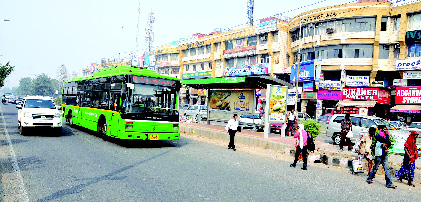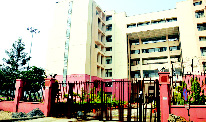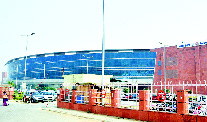
Dwarka was a deserted area till the late 90s, with a handful of people living in an area that had thousands of empty flats. Dwarka is now Asia’s biggest residential colony, covering an area of 5,648 hectares (about 14,000 acres) – more than half of current Gurgaon; there are 29 sectors and more than 300 residential societies. “Dwarka dethroned Rohini as the largest residential colony of Asia; and since then it has been a roller coaster ride for this Sub-City (Suburban City) in terms of development. Although a large area is yet to be developed, it is one of the best areas to live in the whole of NCR. Dwarka is often referred as a ‘Model Township’, as it is being developed under the ‘Urban Expansion Projects’ of the Delhi Development Authority (DDA),” said Sumesh Shokeen, the Member of Legislative Assembly (MLA) from Matiyala seat, under whose area Dwarka falls. “Gurgaon, especially, has done wonders, and being a neighbour of Dwarka, it certainly inspires this Sub-City. Dwarka has uniformity of development across its areas; it is one of the most sought after destinations for affordable yet comfortable living,” added Shokeen.


The Millennium City and the Sub City
Dwarka is a part of Delhi, whereas Gurgaon was developed as a separate city. So, their comparison would be an injustice. But since both these marvels of modern living have been developed on either side of the airport, which is now playing the role of a buffer state, there is much that they can learn from each other. “Dwarka is a Sub-City developed for the sole purpose of residential living, whereas Gurgaon is a full fledged City with all sorts of arrangements – ranging from residential, commercial to industrial. Another difference is that in Gurgaon the development has taken place like a jungle fire, and there is no uniformity whatsoever; whereas Dwarka, though slower in development, has been properly planned. Gurgaon developed all the sky-touching apartments and lavish bungalows without having the basic infrastructure in place; and this is the main reason why Gurgaon is a crumbling city today. Dwarka developed as per the plan, and it has the best civic infrastructure in the whole of NCR; it would remain steadfast even after a decade or two. At present there is 50 to 60 per cent occupancy in Dwarka,” said a retired DDA official living there. Sumesh Shokeen said, “We may not have big malls, large bungalows or an extremely lavish golf club, but we have good basic infrastructure, which is the backbone of civic life. Gurgaon has residential flats worth billions, but outside of them one encounters broken roads with an endless spree of patience-less traffic, and overflowing sewage with pigs floating on it. Gurgaon has been held to ransom by the builders, and the State is losing all its stake as well as its control. I have many friends living in Gurgaon, and almost all of them are repenting their decision to buy a home in Gurgaon. The real estate rates there are beyond the reach of a middle class Indian; whereas Dwarka not only promises a modern infrastructure, but also modern living at affordable rates,” added Shokeen.

Gurgaon offers avant-garde modern living, in front of which not only Dwarka, but any other area in the National Capital Region, would feel inadequate. “Gurgaon is a perfect city for those who have money. You get all items of your need, from a needle to a Ferrari. Of course this City has problems too – such as bad roads, frequent power cuts, lack of public transport, and the paucity of water. But most people are rich enough to buy their comfort,” said Sanjeet Kumar, an executive who lives in Sector-56. Dwarka, no matter how perfectly built, doesn’t have the means for have a lavish life. “I have been living here since 2003. Now we have Metro connectivity to the whole of NCR. We have good markets here. But the fun part is missing from Dwarka. We don’t have any big malls here, we have to go to different markets to buy different things. Night life is also not very great, as there is lack of pubs and discs.
Gurgaon scores some serious brownie points over Dwarka on the health infrastructure. “I am a doctor in a private hospital in Dwarka, and I don’t have any qualms in accepting that Gurgaon has some of the country’s biggest and best hospitals. Dwarka has hospitals such as Rockland, Apollo and Artemis coming up. Till a few years back, if my grandmother had simple chest pain I used to take her to Gangaram Hospital in Delhi. A simple delivery had to be carried out outside. However, as a resident I am happy staying in Dwarka, because it is in Delhi and it offers great connectivity to the whole of NCR,” said Dr. Shilpa Ghosh.
Civic infrastructure is believed to be Gurgaon Achilles heel. Dwarka, on the other hand, has met its destiny with a proper plan in hand. It has been developed from scratch, and the 14,000 acres acquired for development of this (Asia’s biggest) colony were divided and developed wisely by the planners, keeping future demands in mind. The present Dwarka City has been developed assuming a population of 10 lakh people. The infrastructure has been well-maintained. “There are many flats lying vacant in each society. Dwarka’s 29 sectors were made for a population of about 30,000 each; currently about 15,000 people are there in each sector (residential),” said Vikrant Dubey, a resident of Sector-12, Dwarka. In fact Gurgaon has seen a lot of exodus to Dwarka, and people have shifted here in large numbers in the last few years. “Till a couple of years back I was a Gurgaon resident. I used to live in Palam Vihar, in my own house. I left Gurgaon because there was a serious paucity of infrastructure there. No roads, no public transport at all – it was hell for me to travel to my job. Without a car life in Gurgaon is impossible. Here in Dwarka I am living in a flat, which is not as luxurious as my house in Gurgaon; but here we have the Metro at our doorstep, and there is a continuous DTC bus service available in the whole of Dwarka. I am loving this place,” said Subash Rana, a resident, who is a lecturer in the University of Delhi.
Gurgaon is notorious for traffic, chaos, and the non-availability of public transport. “I travel to Gurgaon often, and find the connectivity poor. For Dwarka residents the Metro line goes up to Noida, and on the other side the Airport line touches the contours of Dwarka. The Metro has indeed done wonders for this area; now just because of the Metro it has become one of the most sought after places to live in Delhi. It has placed Dwarka as a part of mainstream Delhi; it’s no more a half-baked rural cum urban sprawl of the nation’s capital. In Gurgaon, the problems begin after one gets down from the Metro. It is pathetic, and the autos there charge exorbitantly, even for small distances,” added Babita, the artist.
Although both places have plenty of good private schools, it’s the presence of a university that makes a big difference. “Dwarka has the biggest college campus in the whole of NCR. Guru Gobind Singh Indrapratha University has opened its biggest campus in Dwarka, and hence our children need not go outside Dwarka for studying in professional courses. Gurgaon has only small campuses of various private universities,” added Shokeen.
Security, especially of women, is perhaps the biggest concern in the NCR. “Gurgaon, in the last two years or so, has seen repeated incidents of molestation, eve teasing, and rape. Dwarka is comparatively better, as we have police presence after every two traffic lights. One can see girls roaming and that too in ‘modern dresses’ even quite late in the evening in the markets,” said Anjali Wadhwa, a resident. While in Gurgaon the crime against women has become a headache for the police, Dwarka has seen far less cases of eve teasing or molestation. “We have six big thanas in Dwarka, along with small pockets, and we keep good vigil. We have kept PCRs after every two traffic lights, as also in markets and other places of public gathering. We are trying our level best to control crime here. However, there have been a few instances of road-side loot at night,” said Surajbhan, a police official in a PCR.
Does a Delhi address still matter?
Having a Delhi address has always been a matter of prestige! Well, this question might fetch many opinions today. To some, having a Delhi address is still a matter of pride and they believe that having a home in Delhi, no matter where it is, is far better than having a house in suburbs like Gurgaon and Noida. “I don’t think it’s a matter of prestige. Earlier I used to live in Gurgaon and I had no problems in admitting to that, even in my circle of professors who mostly live in Delhi. But yes, being in Delhi, no matter which part, does help in getting your work done. The Administration works better. In places like Gurgaon and Noida the babus have become too powerful. A well-functioning Administration gives you a feeling of pride, and Dwarka indeed provides me with this happiness,” added Subhash Rana.
Read More...